If you've been on LinkedIn in the last ten years, you'll know how founders on LinkedIn seem like the next Alix Earle on TikTok, and founder podcasts are the next “Stuff You Should Know.”
If you want to grow your startup without paying for expensive ads, building a founder brand might be for you. In this article, you’ll discover how to build a founder brand and see examples of 3 founders creating professional (and sometimes unprofessional) content to win customers.
@morningbrew Is LinkedIn getting too casual? #linkedin #corporatelife #corporatetiktok @mbdailyshow
♬ original sound - Morning Brew
Founder content is usually on LinkedIn, but founders also post on X/Twitter or have podcasts, YouTube channels, etc. But we'll focus on LinkedIn, the only place where you can see higher-ups discuss business metrics next to the sales memes and shitposts.
We need to distinguish here: Just because a founder posted it doesn't make it founder content. It's when a founder posts strategic marketing and personal branding to:
a) build trust to grow the startup's brand,
b) post useful things that increase their authority, or
c) post something funny and/or memorable to humanize the brand.
Founder-led content marketing is different from brand posting because there's a real actual human attached to it (duh), which gives you a broader range you can talk about to build trust and engage their community. There are 3 core ways you can use to grow your startup with founder content:
General usefulness
This is posting useful stuff like content about changes in the business landscape (everyone loves to say outbound sales is dead, which affects every professional), sharing a product management framework you use (for a specific group of people that fall into a brand’s specific ICP), etc.
This builds trust because useful advice boosts your credibility, espeically if it's better than what a run-of-the-mill consultant would tell you. If people believe your advice, they'll see you as an authority and be more likely to try your product (as long as it's related to what you post about).
Building in Public
Building in public means documenting your journey, showing what you're working on and the results of it.
It's a great excuse to show what you're working on without posting an annoying pitch. Here, you pull back the curtain and build trust through honesty. An honest founder gets more trust, which gets her more customers.
Building in public also means some playfulness in sharing funny mistakes you've made, which engages audiences through humor. If you’re building in public from a very early stage, you can also create buy-in from future customers. Building in public lets you talk about your product directly while the other tactics are much more indirect.
Ragebait/Cringe/Memes
No better way to get clicks than saying something controversial. The more unhinged you are, the more attention you get. This will scare some people away, but the environment has changed - and startups don't have tho be that serious anyway.
Rage baiting gets people outside of your community to engage with you. When used correctly, audiences that are already engaged with a founder will tend to either agree, showing trust, or disagree in the comments which will lead to further reach. Rage baiting is the best way for founders to show off a humorous side and create a topic of conversation when done correctly. When done incorrectly, controversy will turn off any potential customer.
While typically founder content takes place over LinkedIn, the mecca of every professional (and unprofessional) opinion in the world, writing posts is not the only way that founders are sharing their lore and their success stories. Even though written form is the easiest form of content (you can write a post on the toilet or even on the way to the airport), video content in the form of podcasts/interviews or just talking directly to audiences, as well as posting memes (shocker, right) has become increasingly popular over LinkedIn.
How Alex Lieberman grows his brand
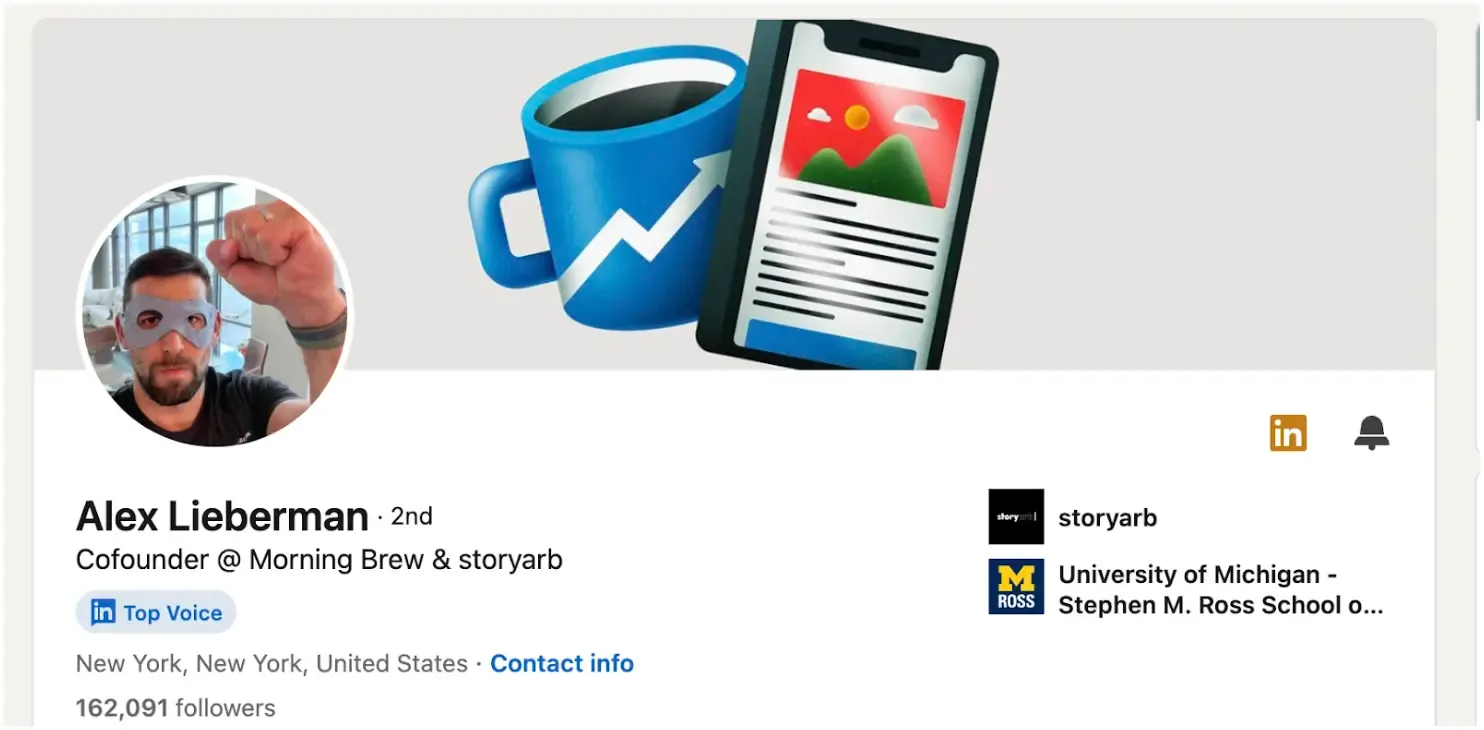
Take Alex Lieberman, for example. Alex founded Morning Brew in 2015 at the University of Michigan as a finance newsletter, which has since skyrocketed to 4 million + subscribers across multiple newsletters and podcasts (and sold for $75m).
Morning Brew is known for their unserious approach to serious topics. This is much reflected in the way that Alex presents himself on his LinkedIn page. Alex posted a video of himself changing his very professional headshot to the superhero-esque photo of him below on LinkedIn this past Friday just for funsies.
Alex regularly uses all three tactics of rage-baiting, general usefulness, and building in public. Even though Alex retired from Morning Brew after he stepped down as CEO in 2021, he has been building Storyarb, which is a content marketing agency focused on execs like him that are trying to engage audiences outside of traditional marketing and community tactics.
He engages his audience by posting about things like gardening reddits and proof that their popularity means there’s always a niche, and he creates general memorability about his page and brand by doing things like changing his profile picture and swearing online (welcome to the club, Alex!).
In context, this actually makes perfect sense as a marketing strategy for StoryArb. He’s showing what his content engine can do for others by demonstrating it on his own page. Even though it’s wildly unserious at times like the time he partnered with Hubspot to play Where’s Waldo at the Superbowl, the engagement on his posts is great.
Alex does not play by the rules of modern professionalism - it seems like he’s having fun while being a full-time CEO, a clear reflection of both Morning Brew and Storyarb’s brand. People like him, people resonate with him, and they want to buy from him. More importantly, content that stands out like Alex’s doesn’t necessarily go viral, but he does take advantage of the fact that making his content more applicable to a broader audience will automatically reach a broader audience on LinkedIn through connections’ likes being dropped onto each other’s feed.
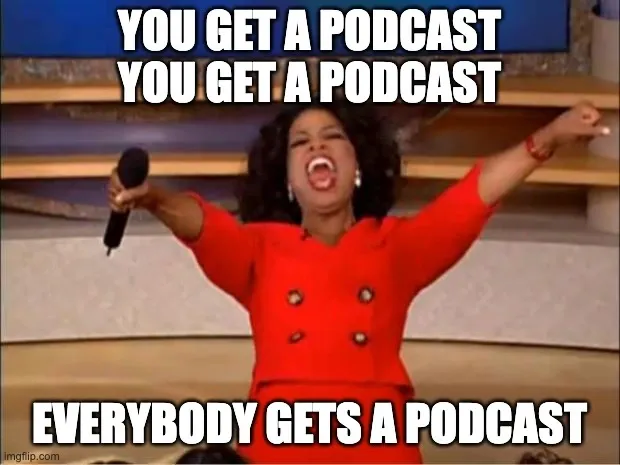
How Gagan Biyani wins with startup wisdom
Humor and unseriousness is not the only path to founder content - using the general usefulness tactic, Maven CEO Gagan Biyani uses his platform to explicitly discuss Maven and learnings from other leaders and CEOs.
If you don’t know what Maven does, then it just seems like another guy adding to the LinkedIn praise echochamber, but if you look a bit further into Maven and realize it’s an e-learning platform, his strategy begins to make a lot more sense.
While it’s not as company-centric as the building in public tactic, Gagan still builds trust with his audience because he talks about generally useful leadership tips which allude to the other, also very useful leadership tips on the Maven platform.
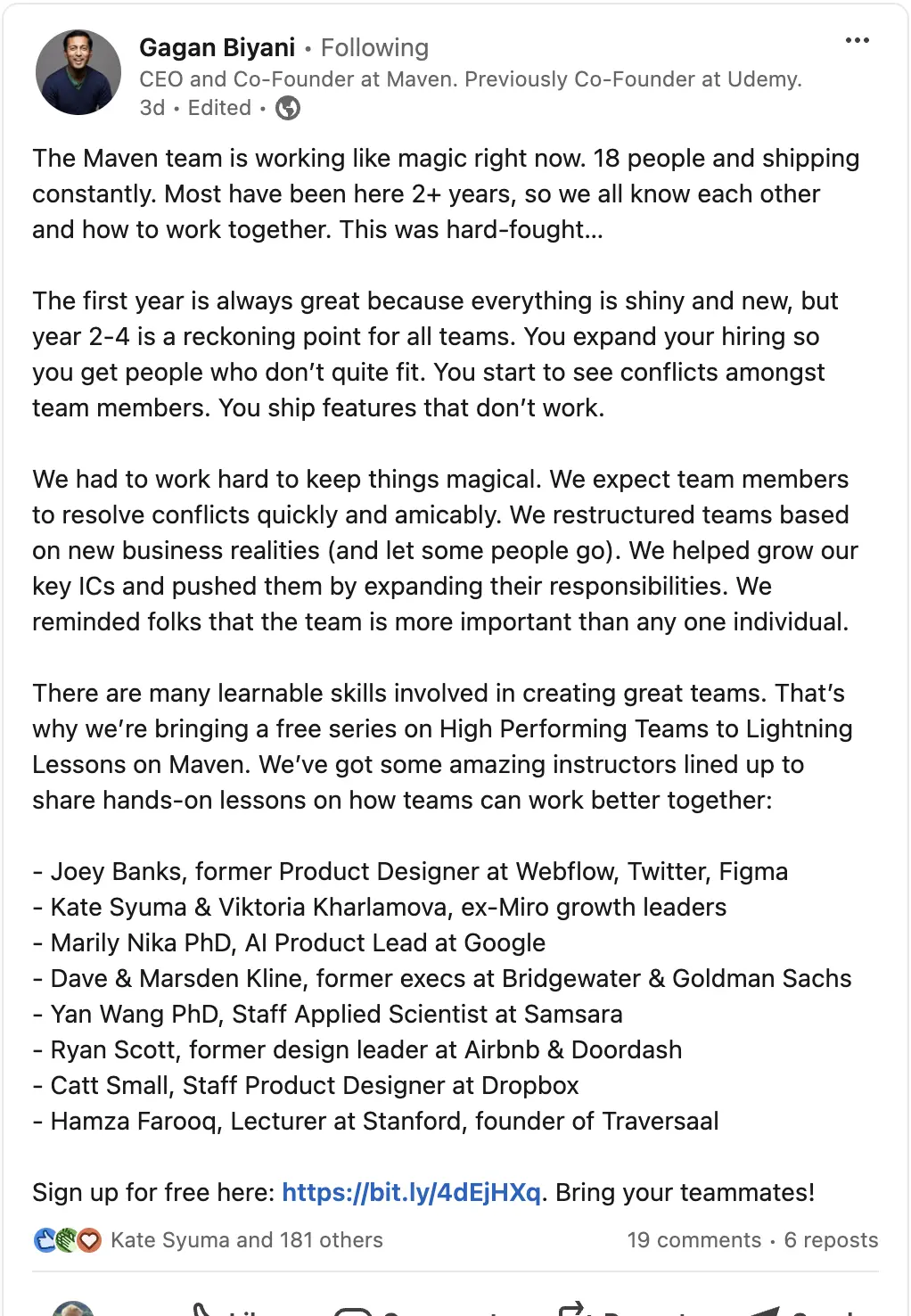
Gagan also isn’t just focused on writing out tips and tricks for the serial founder - he makes frequent appearances on other podcasts to share his lore and wisdom to others, thereby engaging the podcast host’s audience as well as his own by giving them a taste of what they can find in the full podcast while it’s socially acceptable to scroll LinkedIn at work. Fingers crossed that those who listen to the podcast want to buy Maven - that’s the intention of doing these appearances to build trust and give advice with potential current and future buyers.
Is cringey the new cool?
While founders like Gagan and Alex use their platform to build insights and discuss topics like leadership, marketing, and keep the focus lightly on their companies, CEO of Doola Arjun Mahadevan takes a completely different approach. While Arjun may toe the line of satire frequently, he has adopted the building in public methodology with a hint of rage baiting. Arjun does not shy away from talking about his company, Doola, a “business in a box” startup that allows customers to set up their companies and take care of all of their legal and tax needs in one place. His LinkedIn is rife with humorous content about building a company, and he frequently and shamelessly plugs Doola across any post possible.
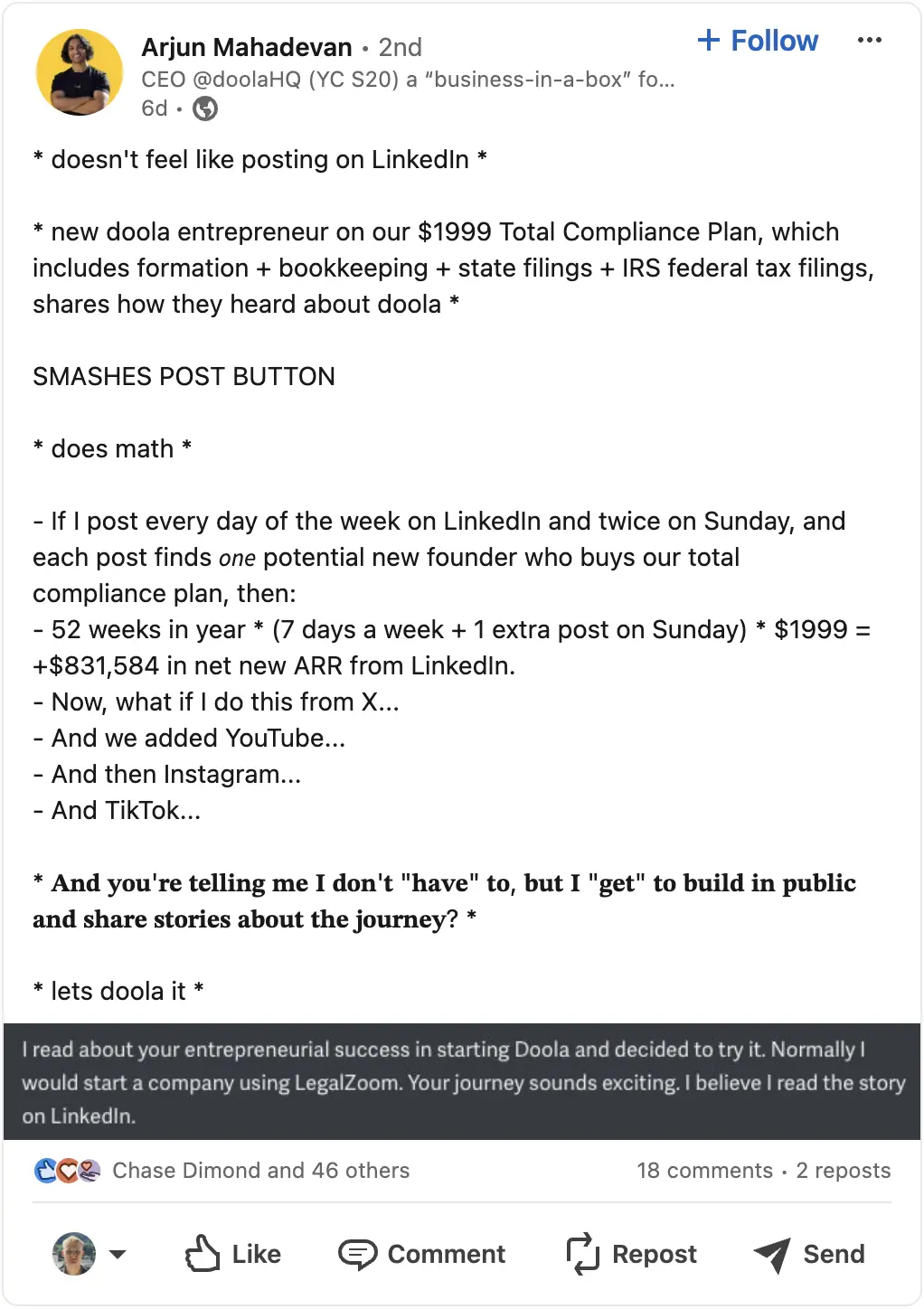
While Arjun does often veer into posting about his early Saturday morning bike rides across NYC as a method of “focus time,” he also will just straight up post his pitch deck to Linkedin, share product roadmaps outside of company all-hands, and talk about his post-gym pump in the same place
Arjun’s LinkedIn presence is super interesting because he leans into being “cringe” - even his background photo shows someone hiking the “mountain of cringe” to reach the “land of cool.”

As a marketing tactic, it’s not often that CEOs embrace being cringe, especially in regards to building in public, which sort of dictates that you share all/most of our successes and failures in public to start a conversation.
While most people might not share the same passion for LLCs, sharing about Doola and being incredibly direct about it actually works. Arjun uses his platform to talk directly about what’s going on in his business, and he’s not putting spinach in pasta sauce as a method of feeding you vegetables when it comes to talking about Doola. His posts are funny and kind of cringey in a way that makes you laugh rather than - well - cringe, and it opens up the door to engage any kind of audience, not just those that can or want to buy Doola.
Is he him?
While Alex, Gagan, and Arjun all come from mostly a non-technical background, CEO of June Enzo Avigo approaches his personal brand as “that guy” for product-market-fit, using the general usefulness tactic to apply to a very specific audience that has heavy overlap with his ideal buyer. Enzo approaches his personal brand as a subject matter expert. His thing is product, he even wrote a book about it called “The First Product Manager.”
His schtick is to educate early product managers about the career path and cater to both experienced and novice PMs with new ways they can be approaching the role or thinking about specific concepts.
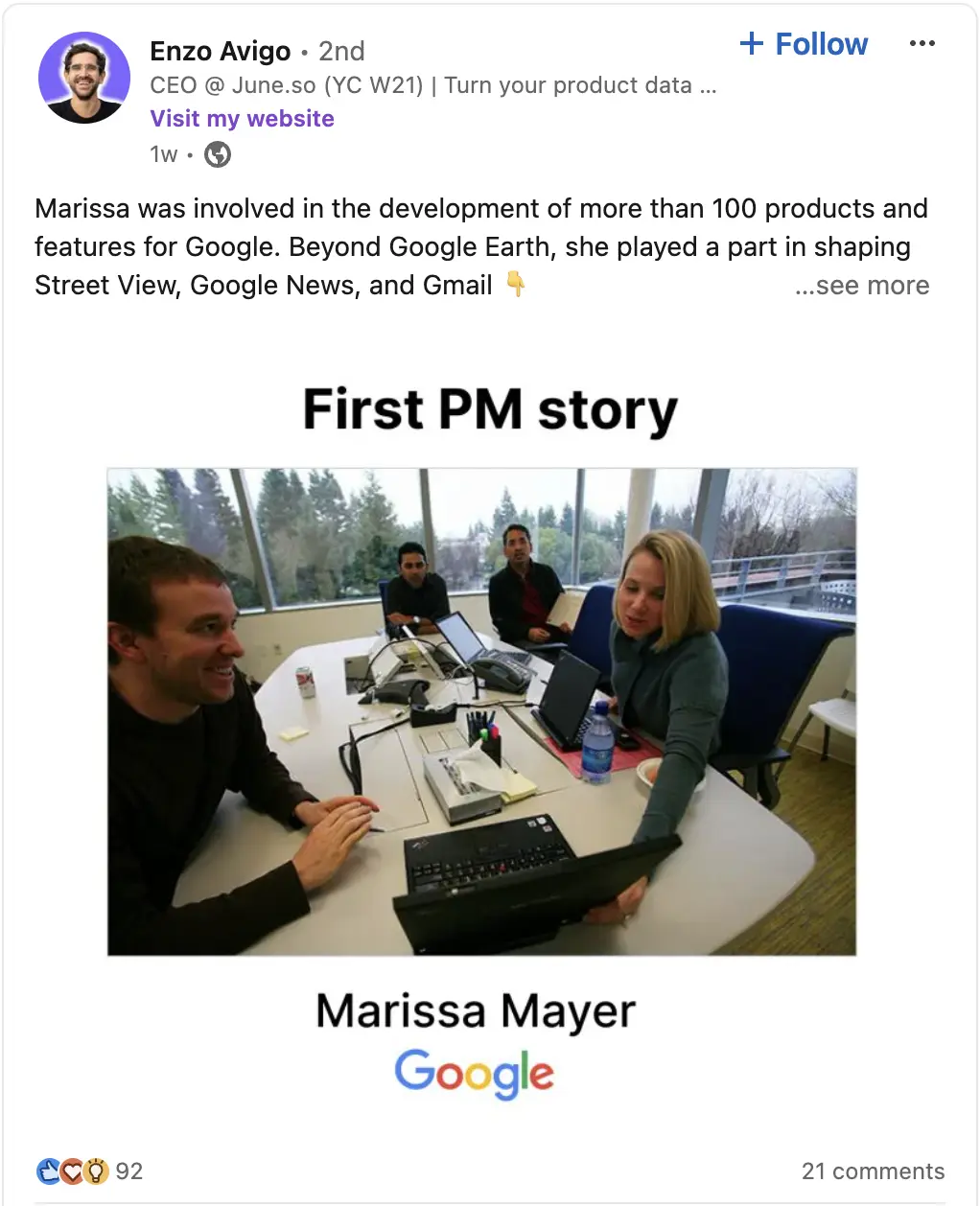
What is unique about Enzo’s approach is that he’s not only writing about tech products. Even though it’s very easy to sink specifically into that rabbit hole, Enzo is able to talk about products like cars, make jokes about submitting tickets for software bugs (which should be familiar to almost all product managers), and give advice to those that are building products for the first time or in a very early-stage startup.
Hence - his advice and posts are generally useful, and he’s not just posting for the sake of June, but also to build trust and be helpful to his audience.
Why does founder content even matter?
A combination of subject matter expertise with clever messaging is exactly the personal brand that founders should be aiming to create which will allow potential customers to connect directly with founders to build trust. Ultimately, leadership that has an outward facing personal brand will have an easier time communicating what their product is about through peer-to-peer communication rather than just a brand communicating. Putting a face to name is one of the most valuable aspects of founder content, and when done right, can lead to a significantly more engaged audience that learns and engages directly rather than passively.
All of this is to say - Alex, Gagan, Arjun, and Enzo are great examples of how to do founder content and engage customers directly and build trust. Nonetheless, personal branding content is also really easy to screw up. Because a lot of B2B marketers are used to speaking with the brand’s voice, rather than an individual voice, messaging can sometimes come across devoid of emotion and cold. If a founder is posting something that is supposed to be written by them but comes off as something that is on the stuffy corporate page, then this may turn off customers from engaging because it’s disingenuous. Conversely, being too silly at the outset can signal to customers that founders don’t fully grasp what they’re doing and are busy making jokes on LinkedIn rather than working.
Even though there are vastly different approaches to founder content, CEOs like Alex, Gagan, Alex, and Enzo show that this is one of the best ways to build a loyal audience and share things that are generally useful, entertaining, and worth reading. This fosters relationships with customers and audience members in general because they can see the people behind the business and feel like they’ve gained something even before engaging in a sales cycle.

















